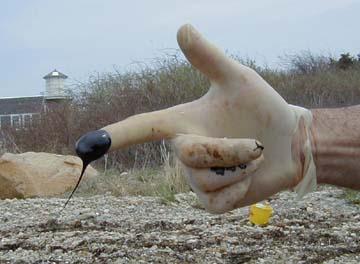Information on No. 6 Fuel Oil
What is No. 6 Fuel Oil
 Number six fuel oil is a heavy oil used by ocean liners and tankers as fuel, and for oil burning power plants (“Bunker C” oil is a heavier variety). It is thick, viscous, and sticky (photo right from Mishaum Point 4/29/03). Its consistency makes it ideal for sea-going skimming operations, but it is much more difficult to treat and cleanup when it lands ashore or on animals. Only 5-10% is expected to evaporate in the first few hours. Its specific gravity is very close to water, so it may float or sink, or do both [Bouchard No. 120 No. 6 continued to float for the first few weeks]. As the lighter hydrocarbons evaporate, the oil can become heavier, and sink.
Number six fuel oil is a heavy oil used by ocean liners and tankers as fuel, and for oil burning power plants (“Bunker C” oil is a heavier variety). It is thick, viscous, and sticky (photo right from Mishaum Point 4/29/03). Its consistency makes it ideal for sea-going skimming operations, but it is much more difficult to treat and cleanup when it lands ashore or on animals. Only 5-10% is expected to evaporate in the first few hours. Its specific gravity is very close to water, so it may float or sink, or do both [Bouchard No. 120 No. 6 continued to float for the first few weeks]. As the lighter hydrocarbons evaporate, the oil can become heavier, and sink.
Number 6 makes a conspicuous “bath tub ring” along shore wherever it lands. Removal is needed where it lands because degradation is very slow, taking months to years. As stated in the fact sheet below: “Adverse effects of floating No. 6 fuel oil are related primarily to coating of wildlife dwelling on the water surface, smothering of intertidal organisms, and long-term sediment contamination. No. 6 fuel oil is not expected to be as acutely toxic to water column organisms as lighter oils, such as No. 2 fuel oil. Direct mortality rates can be high for seabirds, waterfowl, and fur-bearing marine mammals, especially where populations are concentrated in small areas, such as during bird migrations or marine mammal haulouts.”
US NOAA fact sheet on No. 6 Fuel Oil (384 kb pdf file)
NOAA tarball fact sheet (web page with pdf flyer).
We have not yet scanned the Coast Guard No. 6 fuel oil MSD sheet, which does not appear to be from Bouchard. We do not yet know the manufacturer of this fuel. For comparison, review these two No. 6 MSDSs for No. 6 oil from two companies:
Chevron No. 6 MSDS -web versiom
Amarada Hess No. 6 MSDS, pdf version